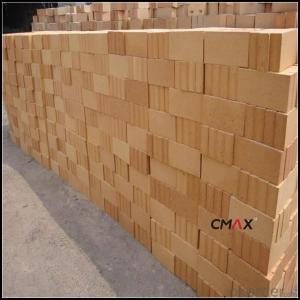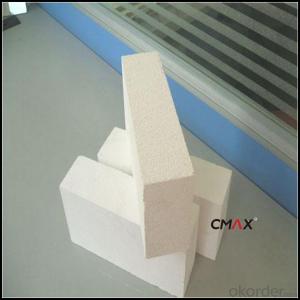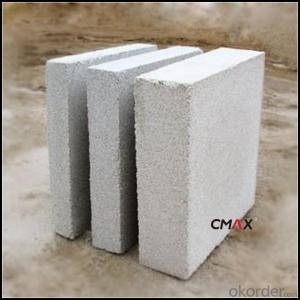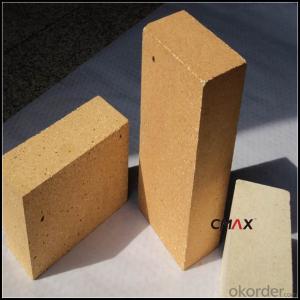High Temprature Insulation Fireclay Refractory brick
- Loading Port:
- China main port
- Payment Terms:
- TT OR LC
- Min Order Qty:
- 2 m.t
- Supply Capability:
- 2000 m.t/month
OKorder Service Pledge
OKorder Financial Service
You Might Also Like
Insulating Brick
CMAX insulating firebricks are classified under temperature between 1300℃ to 1700℃, manufactured from high purity alumina clay.
Insulating fire brick with light weight, has high mini-porosity arranged in average,
keep furnace wall low radiation and depress the charges of fuels.
Light weight for IFB means the lowest thermal storage, it’s quicker to heat and cool, and permit rapid cycle work.They are used for 900℃ -1650℃ customer can select the most economical products according to service temperature.
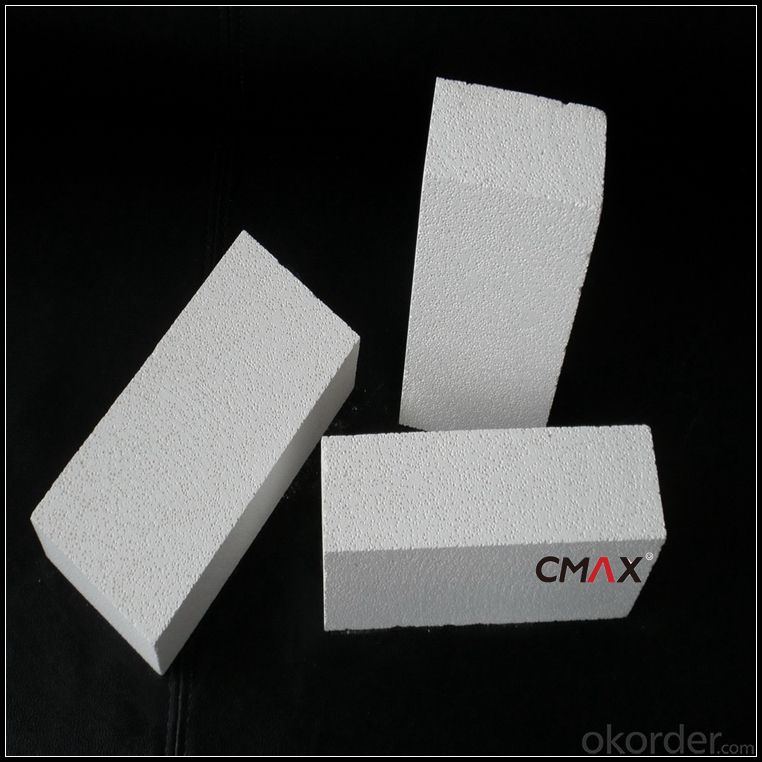
Insulating Brick Features
1. Good price
2. Raw material from China, Australia and Germany
3. Certificate of Quality for each parcel
4. Many sizes in stock ; Making tiles accroding to your drawings
5. Resistance: Excellent
6. Quick delivery& Professional service
Insulating Brick Application
High-temperature kiln and furnace hot face’s lining
Insulating backup
Infra red element support
Glass tank side and end wall & port neck insulation
Nuclear insulation application
Industrial combustion chamber construction
Insulating Brick Data Sheet
Classification Temperature (℉/℃) | 3000/1650 |
Bulk Density (g/cm3 ) | ≤1.0 |
Thermal Conductivity | |
800℃, W/m.K | ≤0.39 |
1000℃, W/m.K | ≤0.43 |
1200℃, W/m.K | ≤0.48 |
Reheating Linear Change (%) | 1550℃×12h |
≤0.9 | |
Chemical Composition (%) | |
Al2O3 | ≥75 |
Fe2O3 | ≤0.5 |
Packaging & Shipping
Packaging Details:Be packed in fumigated wooden pallets
Delivery Detail: 30 days after order

Our Services
Optimum solution and product supply of refractories for high temperature industries, such as iron steel, non-ferrous, petrochemical and building materials.
Engineering design, contract and consult for refractories, and civil architecture design.
Research, development, manufacture and sale of superhard materials.
R&D, manufacture and sale of special packing materials for export.
Inspection, supervision and arbitration of refractories.
Consultation and services in refractories information.
Training and cultivation of high-level talents in refractories profession
Sales Network

Company Information
CNBM (China National Building Material) Group is the largest comprehensive building materials group in China that in integrate scientific research, manufacturing and logistics into one entity. The largest building materials and equipment specialists in China. Upon State Council approval, today CNBM owned more than 300 subordinate manufacturing factories and servicing companies. There are 6 fully owned public listed companies and 11 partially owned with substantial shares public listed companies. In many of these fields, CNBM is playing the leading role in the building industry in the country.
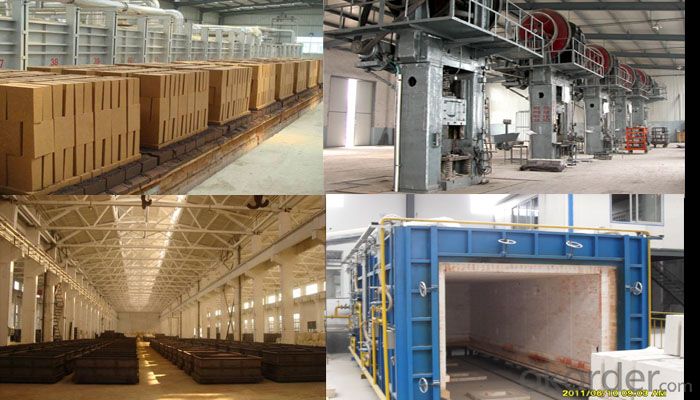
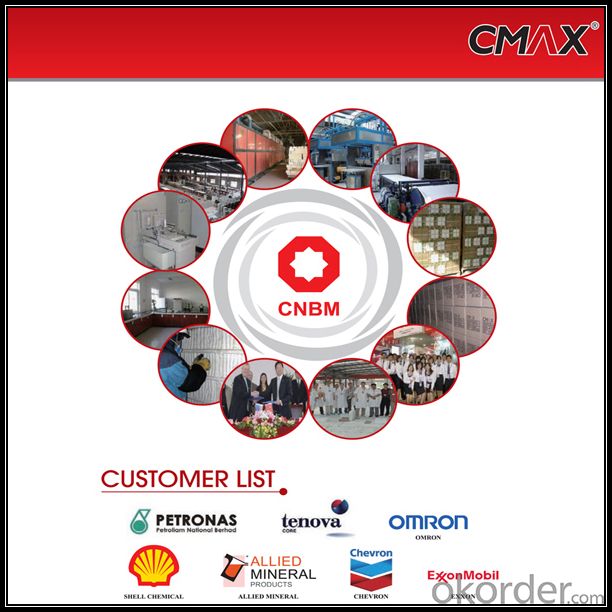
FAQ
1. Which products do you have?
We have all kinds of refractory brick, castable, mortar, cement, ceramic fiber products, etc.
Or you could browse our products to choose what you need.
2. Can you give me a brief introduction of the application of your products?
We are mainly specializing in the refractory materials in iron and steel, cement, glass, ceramics, petrochemical, electric power Industry, etc.
3. If I need your offer, what information do you need?
In order to choose suitable products, it will be appreciated to provide us the information, such us specification, technical data, order quantity, products application etc. If any question, please contact us freely.
- Q:Can insulating fire bricks be used for chimney lining?
- Yes, insulating fire bricks can be used for chimney lining. Insulating fire bricks are specifically designed to withstand high temperatures and are excellent at retaining heat. They have a low thermal conductivity which helps to prevent heat loss and improve the efficiency of the chimney. Additionally, insulating fire bricks are resistant to cracking and spalling, making them a durable option for chimney lining. However, it is important to ensure that the insulating fire bricks used are suitable for the specific type of chimney and comply with local building codes and regulations.
- Q:Can insulating fire bricks be used in hydrogen furnaces?
- Insulating fire bricks can be used in hydrogen furnaces, but it is important to note that not all types of insulating fire bricks are suitable for this application. Hydrogen is a highly reactive gas and can cause certain materials to degrade or react, leading to safety concerns and potential damage to the furnace. When selecting insulating fire bricks for use in hydrogen furnaces, it is crucial to choose bricks that are specifically designed for high-temperature and corrosive environments. These bricks should be made from materials that are resistant to hydrogen embrittlement and have low reactivity with hydrogen. Silicon carbide (SiC) and alumina-silica (Al2O3-SiO2) are commonly used materials for insulating fire bricks in hydrogen furnaces. These materials have good resistance to high temperatures and are chemically stable in the presence of hydrogen. It is also important to consider the density and porosity of the insulating fire bricks. Low-density bricks with high porosity are preferred for hydrogen furnaces as they provide better thermal insulation and reduce the risk of hydrogen leakage. Overall, while insulating fire bricks can be used in hydrogen furnaces, it is crucial to select the appropriate type of bricks that are specifically designed for high-temperature and corrosive environments, and have good resistance to hydrogen embrittlement and reactivity. Consulting with experts in the field and following the manufacturer's guidelines is highly recommended to ensure the safe and efficient operation of the hydrogen furnace.
- Q:Are insulating fire bricks fireproof?
- Indeed, insulating fire bricks possess fireproof properties. Their design allows them to endure elevated temperatures while offering insulation to impede heat transfer. Composed of refractory materials with a high melting point, insulating fire bricks can withstand intense heat without disintegrating or liquefying. These bricks are frequently employed in scenarios involving high temperatures, such as kilns, furnaces, fireplaces, and ovens. As a means of fireproofing, insulating fire bricks are highly recommended due to their exceptional thermal insulation capabilities and their ability to effectively safeguard against the propagation of fire.
- Q:Can insulating fire bricks be used for pizza ovens?
- Yes, insulating fire bricks can be used for pizza ovens. Insulating fire bricks are designed to withstand high temperatures, making them a suitable choice for creating a well-insulated and efficient pizza oven. They help retain heat, allowing the oven to reach and maintain the desired temperature for baking delicious pizzas.
- Q:How do insulating fire bricks contribute to reducing heat loss?
- The unique thermal properties and design of insulating fire bricks aid in the reduction of heat loss. These bricks are composed of insulating materials, such as ceramic fibers or lightweight refractory aggregates, which possess low thermal conductivity. Consequently, they do not readily conduct heat, preventing the transfer of heat from one side of the brick to the other. Moreover, the structure of insulating fire bricks contains small air pockets or voids within the material. These air pockets function as barriers to heat, as air is a poor conductor of heat. As heat attempts to traverse the brick, it becomes trapped within these voids, significantly diminishing heat transfer. The insulating qualities of these bricks are beneficial in various applications, including industrial furnaces, kilns, and fireplaces. By utilizing insulating fire bricks as lining or insulation material, heat loss from these systems is minimized. This not only helps maintain a more consistent and uniform temperature within the enclosed space but also enhances energy efficiency by reducing wasted heat. Additionally, insulating fire bricks exhibit resistance to high temperatures, ensuring that they do not deteriorate or lose their insulating abilities when exposed to extreme heat. This durability enables them to provide long-lasting insulation and contribute to the reduction of heat loss over an extended period. In conclusion, insulating fire bricks are highly effective in decreasing heat loss due to their low thermal conductivity, presence of air pockets, and resistance to high temperatures. Their integration into various thermal systems aids in conserving energy, enhancing thermal efficiency, and creating a more comfortable and controlled environment.
- Q:Refractory bricks, burner bricks, insulation bricks? Is it a kind of thing?
- The burner brick is heavy brick, the use temperature is higher, the insulating brick is light brick, the use temperature is lower than the heavy brick.
- Q:Can insulating fire bricks be used in the construction of thermal insulation roofs?
- Yes, insulating fire bricks can be used in the construction of thermal insulation roofs. Insulating fire bricks are specially designed to have high thermal insulation properties, making them an ideal choice for applications that require heat retention and energy efficiency. These bricks are made from lightweight materials such as clay, which have low thermal conductivity and high resistance to heat transfer. This allows them to effectively reduce heat loss or gain, making them suitable for use in thermal insulation roofs. Additionally, insulating fire bricks are durable and can withstand high temperatures, making them a reliable choice for long-term use in roofing applications.
- Q:Can insulating fire bricks be used in refractory castings?
- Indeed, refractory castings can incorporate insulating fire bricks. Due to their lightweight nature and exceptional insulation abilities, insulating fire bricks are ideal for tasks that demand thermal insulation. Such tasks include the creation of linings in furnaces, kilns, and other equipment that operates at high temperatures. To achieve thermal insulation and minimize heat loss, insulating fire bricks can be utilized either as a layer or as an element within the refractory casting mixture. Furthermore, their low thermal conductivity aids in reducing energy consumption and sustaining elevated temperatures within the casting.
- Q:Do insulating fire bricks have a high resistance to spalling?
- Yes, insulating fire bricks have a high resistance to spalling. Spalling refers to the breaking off or flaking of the surface of a material, and in the case of fire bricks, it typically occurs due to high temperatures and thermal shock. Insulating fire bricks are specifically designed to withstand these extreme temperatures and thermal cycling, making them highly resistant to spalling. These bricks are made from high-quality refractory materials, such as alumina or silica, which have excellent thermal shock resistance. Additionally, they are manufactured with a low thermal conductivity, which helps to minimize heat transfer and reduce the risk of spalling. Overall, insulating fire bricks are an ideal choice for applications where high resistance to spalling is required, such as in furnaces, kilns, and other high-temperature environments.
- Q:Can insulating fire bricks be used in heat treatment furnaces?
- Yes, insulating fire bricks can be used in heat treatment furnaces. Insulating fire bricks are designed to withstand high temperatures and provide excellent insulation properties, making them suitable for use in heat treatment furnaces where high temperatures are required. These bricks help to retain heat, minimize energy loss, and ensure efficient heat distribution throughout the furnace, resulting in improved heat treatment processes.
1. Manufacturer Overview |
|
|---|---|
| Location | |
| Year Established | |
| Annual Output Value | |
| Main Markets | |
| Company Certifications | |
2. Manufacturer Certificates |
|
|---|---|
| a) Certification Name | |
| Range | |
| Reference | |
| Validity Period | |
3. Manufacturer Capability |
|
|---|---|
| a)Trade Capacity | |
| Nearest Port | |
| Export Percentage | |
| No.of Employees in Trade Department | |
| Language Spoken: | |
| b)Factory Information | |
| Factory Size: | |
| No. of Production Lines | |
| Contract Manufacturing | |
| Product Price Range | |
Send your message to us
High Temprature Insulation Fireclay Refractory brick
- Loading Port:
- China main port
- Payment Terms:
- TT OR LC
- Min Order Qty:
- 2 m.t
- Supply Capability:
- 2000 m.t/month
OKorder Service Pledge
OKorder Financial Service
Similar products
New products
Hot products
Related keywords

